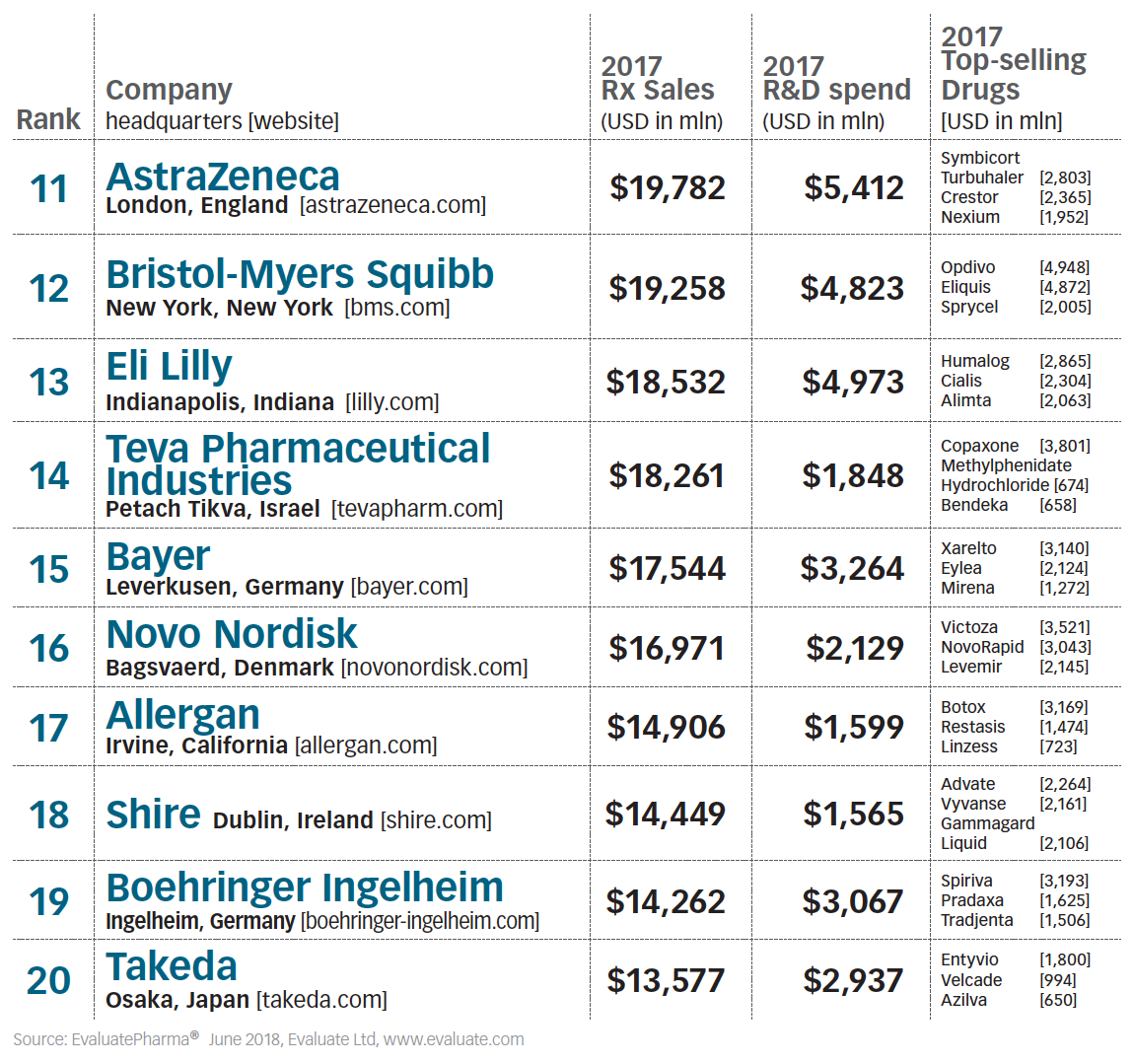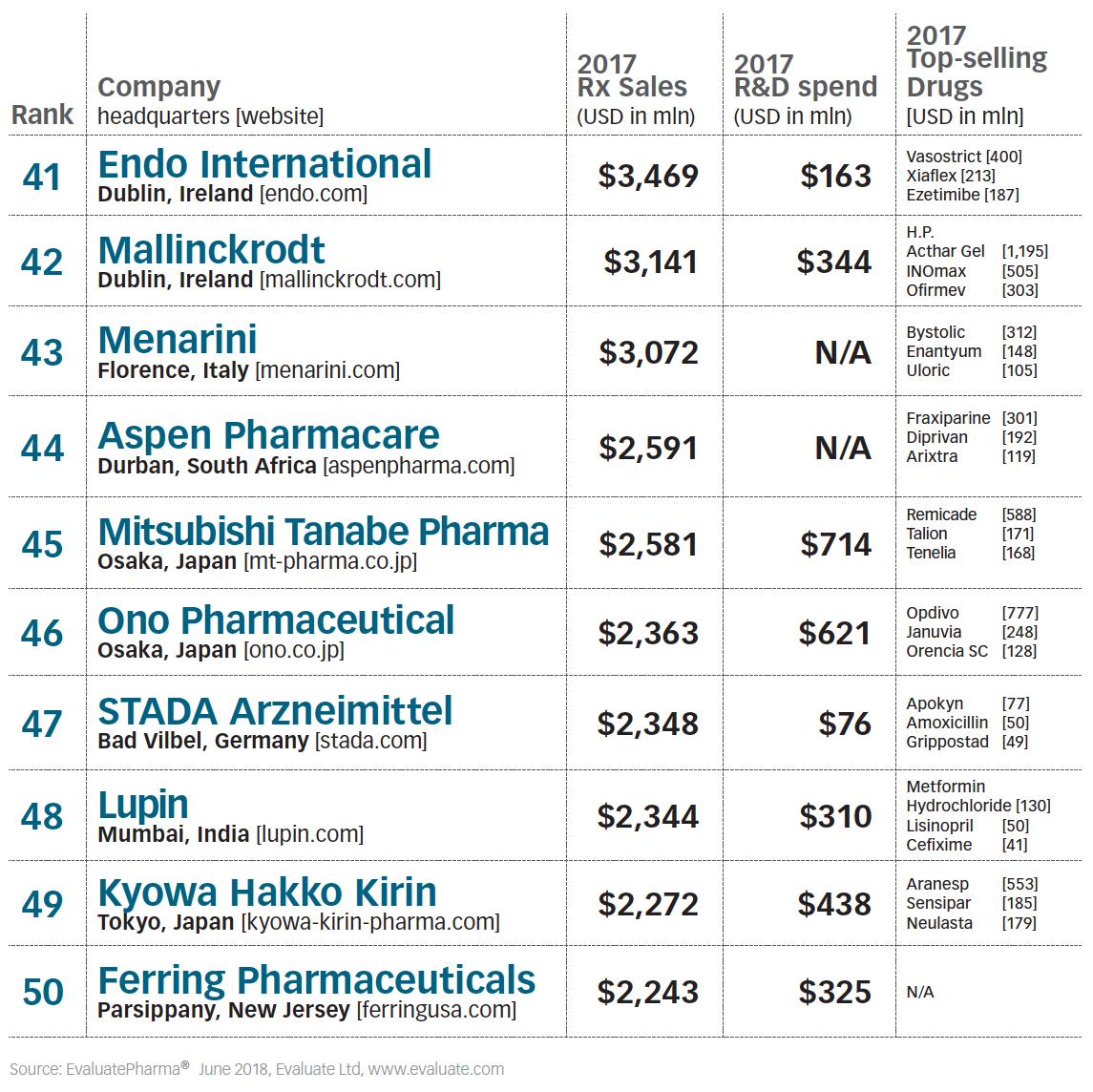Pharm Exec's Top 50 Companies 2018
Pharmaceutical Executive
Pharm Exec’s 18th annual listing of the top biopharma players shows that most of the familiar placeholders are holding their ground as they weigh a changing business climate with new opportunities for growth in a potentially resurgent marketplace.

Pharm Exec’s annual listing of the top biopharma players shows that most are holding their ground as they weigh a more challenging business climate with new opportunities for growth in a potentially resurgent marketplace
Amid all the swirling changes in the biopharmaceutical and healthcare marketplaces-from therapeutic advances on one side to access, pricing, and business pressures on the other-our latest annual list of the top 50 global biopharma sales leaders remained remarkably stable. The first 10 spots on the ledger, once again led by Pfizer, changed little from the previous full-year rankings, with some movement of positions up or down a slot. Prescription sales gains among the entrenched stalwarts were relatively modest, on average, with AbbVie and Johnson & Johnson experiencing the largest increases at 9.7% and 8.6%, respectively. In assembling the data for the annual listing-now in its 18th year-Pharm Exec partnered again with life sciences market intelligence firm Evaluate Ltd.
Sanofi, ranked sixth in sales, boosted its R&D investment by 8.1% versus the previous year. The Paris-based company currently has 28 projects in Phase III development or seeking approval with regulators, and has six programs targeting rare diseases in Phase II or III clinical trials. It’s no secret that, overall, industry investment in rare disease drugs-on the investigative and commercial-expansion stages-is on the rise. The FDA, for example, reportedly granted 77 orphan drug approvals last year and 476 orphan drug designation requests.
Among the top 20 sales leaders on our list, other companies with notable spikes in R&D spending year-on year include AbbVie at 16.3%, Shire at 21.6%, and Bristol-Myers Squibb, which invested $4.82 billion in R&D, at 9.5%.
Biopharma’s bottom line in 2017 was impacted by US tax reform passed late in the year, which limited overall profit for some, with drugmakers having to pay large one-time charges related to the changes. Going forward, however, the tax reform, which lowered the income tax for US companies to 21%, is expected to spur a resurgence in life sciences M&A. It may already have, with several smaller-scale acquisitions announced by big pharma so far this year. Could such dealmaking, combined with larger, global moves, including Takeda’s proposed $62 billion acquisition of Shire last month, rearrange some of the positioning in our Pharma 50 listing come next year? The Takeda-Shire combo would thrust the new organization into the top 10, reports say.
Continued focus in political and other circles to curb drug pricing could influence the jockeying as well. Although it’s difficult to gauge the immediate impact of some efforts, such as the US Administration’s newly unveiled strategy to reform pricing, which didn’t include specific timelines on policy implementation. What is more certain is the likely continued penetration of specialty drug products within the overall pharma market-a factor that has contributed to higher prescription medicine costs, even as some reports have predicted branded drug spending in developed countries will actually fall this year and remain flat in the near-term.
With all the different dynamics at play, the importance of having strong and stable leadership has perhaps never been more critical for biopharma. Which brings us again to this year’s special Pharma 50 accompanying feature by guest authors at the executive search and talent advisory firm Russell Reynolds Associates. It’s clear organizations today are facing mounting market pressures, as the traditional commercial model has become increasingly challenged. The old methods of leadership assessment, therefore, are now myopic, the authors contend, and new perspectives on identifying and benchmarking the character profile of effective C-suite leaders-with the makeup to lead over the long term-are needed. In the pages ahead, Russell Reynolds presents such an approach, using a framework of eight personality dimensions and applying them across all industries to extract those vital and distinctive leadership traits that will best predict “C-suite durability” in the world of biopharma.
See how the top 50 biopharma revenue generators in prescription drug sales stack up ahead (click on the tables to enlarge).





Cell and Gene Therapy Check-in 2024
January 18th 2024Fran Gregory, VP of Emerging Therapies, Cardinal Health discusses her career, how both CAR-T therapies and personalization have been gaining momentum and what kind of progress we expect to see from them, some of the biggest hurdles facing their section of the industry, the importance of patient advocacy and so much more.